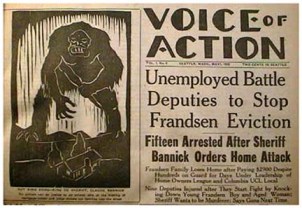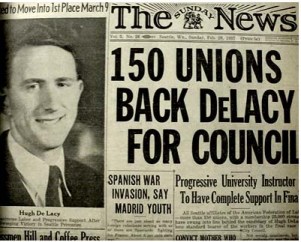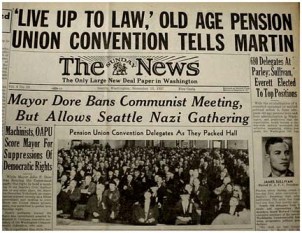 Apart from New York and San Francisco, no city claimed a more active and enduring Communist Party press than Seattle. Headquartered in New York, the CP based its major newspaper, The Daily Worker, its magazine, New Masses, and other periodicals in that city. After 1932, San Francisco hosted a second major newspaper, the Western Worker which was renamed the People's World in 1938
Apart from New York and San Francisco, no city claimed a more active and enduring Communist Party press than Seattle. Headquartered in New York, the CP based its major newspaper, The Daily Worker, its magazine, New Masses, and other periodicals in that city. After 1932, San Francisco hosted a second major newspaper, the Western Worker which was renamed the People's World in 1938
The party's District 12 office in Seattle encouraged several short-lived publications in the 1920s, including The Spark, a lively mimeographed newsletter published by the University of Washington chapter of the Young Communist League. In 1933, shortly after Lowell Wakefield returned to Seattle in a party leadership rotation, the party began publishing the Voice of Action, with Wakefield serving as editor.
 The Voice of Action published weekly for three years and party members sold copies and circulated it in cities and towns of Washington and nearby states. Party ownership was not openly proclaimed until 1935, but the militant weekly was firmly controlled by the District 12 Executive committee. Well written, with loud headlines and eye-catching graphics, the weekly devoted much attention to the plight of unemployed workers in the Washington area, promoting the activities of the Communist controlled Unemployed Councils. Party efforts to organize unions, especially in the timber industry, were another focus.
The Voice of Action published weekly for three years and party members sold copies and circulated it in cities and towns of Washington and nearby states. Party ownership was not openly proclaimed until 1935, but the militant weekly was firmly controlled by the District 12 Executive committee. Well written, with loud headlines and eye-catching graphics, the weekly devoted much attention to the plight of unemployed workers in the Washington area, promoting the activities of the Communist controlled Unemployed Councils. Party efforts to organize unions, especially in the timber industry, were another focus.
Here are two reports about the newspaper:
The Voice of Action by Christine Davies
The Voice of Action: A Paper for Workers and the Disenfranchised, by Seth Goodkind
See our collection of more than 210 articles from the Voice of Action
 In 1936, the Party closed the Voice of Action in order not to compete with the Commonwealth News, a weekly published by the Washington Commonwealth Federation. The WCF had been created two years earlier by radicals who hoped to turn the Democratic Party to the left. Embracing a broad coalition of interests, the WCF nominated candidates for state and local offices and promoted ballot measures and other political initiatives. Many of its candidates were successful and at times the WCF exercised considerable influence in the state legislature and in Washington's Congressional delegation. Fearing the disruptive tactics of Communists, the early WCF banned CP members, but after 1935 Communists became more and more influential in the organization as WCF leaders like Howard Costigan and Hugh DeLacy became party supporters or members.
In 1936, the Party closed the Voice of Action in order not to compete with the Commonwealth News, a weekly published by the Washington Commonwealth Federation. The WCF had been created two years earlier by radicals who hoped to turn the Democratic Party to the left. Embracing a broad coalition of interests, the WCF nominated candidates for state and local offices and promoted ballot measures and other political initiatives. Many of its candidates were successful and at times the WCF exercised considerable influence in the state legislature and in Washington's Congressional delegation. Fearing the disruptive tactics of Communists, the early WCF banned CP members, but after 1935 Communists became more and more influential in the organization as WCF leaders like Howard Costigan and Hugh DeLacy became party supporters or members.
The Commonwealth News and its successor newspapers reflected the growing Communist influence. Several party members served in editorial positions, most notably Terry Pettus who edited the Washington New Dealer and the New World from 1938 to 1948, when the last of the communist-influenced newspapers folded. The WCF newspapers went through six name changes:
 Washington Commonwealth Builder (Aug 1934-October 1935)
Washington Commonwealth Builder (Aug 1934-October 1935)
Here are detailed reports on three of the weeklies in the WCF sequence:
The Washington Commonwealth Builder and Washington Commonwealth News by Jessica DonahooThe Washington Commonwealth Builder and the Washington Commonwealth were the first of a series of names given to a weekly paper issued by the Washington Commonwealth Federation, a leftwing group in which Communists were active after 1936. This report describes the newspaper from 1934-1936 and includes digital images of selected articles.
The Washington New Dealer by Joshua SteckerThe Washington New Dealer was the fifth in a series of weekly newspapers sponsored by the Washington Commonwealth Federation (WCF). Published between 1938-1942, it was edited by Terry Pettus and strongly influenced by the Communist Party. This report describes the newspaper and includes digital images of selected articles.
See our collection of digitized articles from the Washington Commonwealth Federation newspapers.